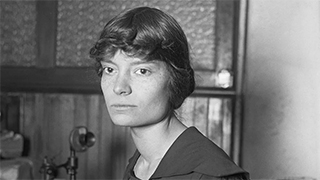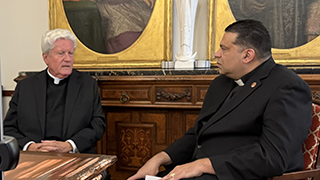Professor Quinn on Seton Hall’s History: The “A Microcosm of a Larger Story” - Seton Hall University
Wednesday, May 10, 2023

The evening opened with welcoming remarks by Jonathan Farina, Ph.D., interim associate provost for undergraduate education and assessment. “His history of Seton Hall shares a balance of beautifully smooth sentences that blend respect and appreciation for the institution with an enjoyable measure of skepticism, humor and human detail,” noted Farina.
Father Colin Kay, vice president for mission and ministry, then led the audience in an opening prayer, and following a short video message from University President, Joseph E. Nyre, Ph.D., the main program began.
President Emeritus Monsignor Robert Sheeran approached the podium, sharing the story of how Seton Hall University: A History, 1856-2006 came to be. During his service as the University’s 19th president, Monsignor Sheeran commissioned the historian to develop the scholarly work, commenting on Professor Quinn’s masterful narrative building as a writer.
“Professor Quinn is extraordinary adept at many things, but in this book and in his earlier writings, he takes a bunch of disparate facts and various experiences – some soft, some hard – and puts them together, creating from them a believable and richly textured narrative that gives the story at all levels,” said Monsignor Sheeran. “That is what we have in this history of Seton Hall University.”
Before welcoming Profession Quinn to the stage, Monsignor Sheeran invited the audience to reflect on the story of Seton Hall as a story of American higher education and the Catholic Church in the United States in miniature. “Thank you, Professor Quinn, for this masterful history. It is an extraordinary labor of love that links us to our rich traditions and enduring legacy,” he closed.
Throughout the evening, Professor Quinn walked the audience through highlights of the 150 year period, exploring the institution’s growth from its founding by Bishop James Roosevelt Bayley through the legacy of presidencies including Father Bernard J. McQuaid, Monsignor Thomas McLaughlin, Seton Hall’s youngest president, Monsignor James Kelly, and many more.
Weaving in historical photos of Seton Hall’s buildings, campus, leaders and even students, Professor Quinn also touched on the impact of individuals who may not be recognized by name, but whose impact is readily prominent in the community – such as Jeremiah O’Rouke, the designer and architect of President’s Hall and the Chapel of the Immaculate Conception.
“Such is the baldest summary of this book, or more precisely, it is not the only way to think of the Seton Hall story,” said Quinn in the closing remarks of his presentation. “The history of Seton Hall is also the history of everything else.”
Highlighting the University’s position among various, intersecting histories over the years, Quinn added, “If you want to know the history of New Jersey… the history of immigration and assimilation… the history of urbanization and suburbanization… the history of the Catholic Church, start here.”
Released earlier this year, Seton Hall University: A History, 1856-2006 covers a wide range of topics, including the University's Catholic mission, through the fascinating lens of the men and women who helped shape the educational institution – and includes numerous archival photos to bring Seton Hall’s history to life.
For more information, please visit the book’s listing on the Rutgers University Press website or Amazon.
Categories: Arts and Culture, Faith and Service






